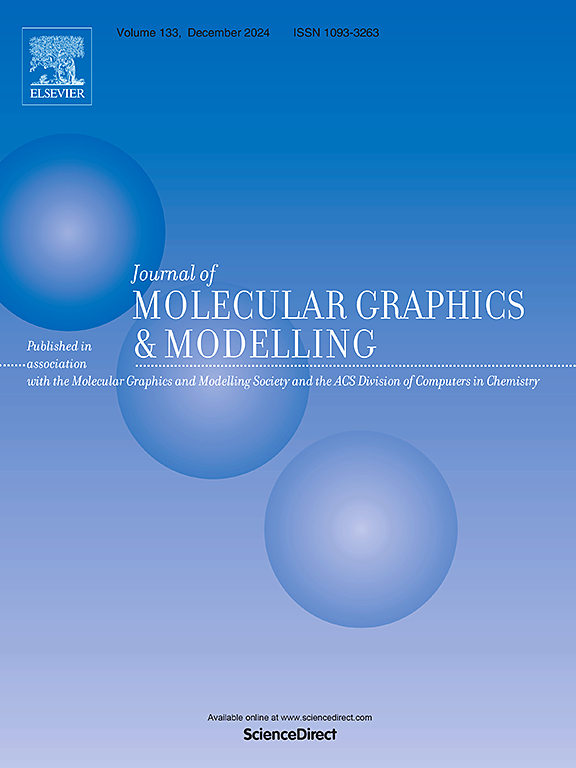蜂胶化合物的筛选揭示了鼻病毒3C蛋白酶的潜在抑制剂:一个计算研究
IF 3
4区 生物学
Q2 BIOCHEMICAL RESEARCH METHODS
引用次数: 0
摘要
背景和目的鼻病毒是呼吸道感染的主要原因,并常常加重哮喘等病症。蛋白3C蛋白酶在阻止病毒复制方面起着至关重要的作用。这项研究探索了天然抑制剂的潜力,特别是针对蛋白3Cpro的蜂胶化合物,与标准的合成抑制剂Rupintrivir相比,它是一种有前景且毒性更低的替代品。选取60个蜂胶衍生分子,进行分子对接模拟,评价其与3Cpro的结合亲和力,并对配体与3Cpro蛋白的相互作用进行可视化分析。通过200ns分子动力学(MD)模拟评价了蛋白-配体复合物的稳定性,分析了RMSD、RMSF、SASA、Rg、氢键等分子动力学参数。利用MM-PBSA进一步估计了结合自由能,并进行了每残基能量分解以确定关键的稳定相互作用。结果Rutin和Retusapurpurin A的结合能分别为−8.0 kcal/mol和−8.78 kcal/mol,优于参比抑制剂Rupintrivir(−6.66 kcal/mol)。MD模拟结果表明,两种配体均能有效稳定3Cpro, RMSD值分别为1.02±0.10 nm和1.21±0.22 nm,且在袋内的稳定性优于Rupintrivir。这些配体还降低了RMSF、SASA和Rg评分。MM-PBSA计算结果显示,芦丁(- 35.65 kcal/mol)和Retusapurpurin A (- 31.59 kcal/mol)的结合能优于Rupintrivir (- 25.44 kcal/mol)。残基分解进一步揭示了催化位点残基(His40, Glu71和Cys147)的强大能量贡献,特别是在芦丁络合物中。结论潜在化合物芦丁和reusapurpurin A是很有潜力的3Cpro抑制剂,其潜在疗效较ruintrivir有所提高。这些结果为开发从蜂胶中提取的天然抗病毒药物铺平了道路,并支持将其用作治疗鼻病毒感染的膳食补充剂。蜂胶的化学多样性可以限制病毒耐药性的出现。然而,需要体外和体内实验验证来证实这些观察结果。本文章由计算机程序翻译,如有差异,请以英文原文为准。

Screening of Propolis compounds reveals potential inhibitors of rhinovirus 3C protease: A computational study
Background and aim
Rhinoviruses are major causes of respiratory infections and often aggravate conditions such as asthma. The protein 3C protease plays a crucial role as it blocks the virus replication. This study explores the potential of natural inhibitors, specifically Propolis compounds targeting the protein 3Cpro, which is a promising and less toxic alternative compared to the standard synthetic inhibitor, Rupintrivir.
Experimental procedure
A set of 60 propolis-derived molecules was selected and prepared for molecular docking simulations to evaluate their binding affinity to 3Cpro, then ligand-3Cpro protein interactions were visualized. A 200ns molecular dynamics (MD) simulation was conducted to assess the stability of the protein-ligand complexes, then the following MD parameters were analyzed: RMSD, RMSF, SASA, Rg, and hydrogen bonding. Binding free energies were further estimated using MM-PBSA, and per-residue energy decomposition was performed to identify key stabilizing interactions.
Results
The potential compounds Rutin and Retusapurpurin A displayed binding energies of −8.0 kcal/mol and −8.78 kcal/mol, respectively, outperforming the reference inhibitor Rupintrivir (−6.66 kcal/mol). MD simulations revealed that both ligands effectively stabilize 3Cpro, with RMSD scores of 1.02 ± 0.10 nm and 1,21 ± 0.22, respectively, and are also more stable in the pocket than Rupintrivir. These ligands also reduced RMSF, SASA, and Rg scores. MM-PBSA calculations showed more favorable binding energies for Rutin (−35.65 kcal/mol) and Retusapurpurin A (−31.59 kcal/mol) compared to Rupintrivir (−25.44 kcal/mol). Per-residue decomposition further revealed strong energetic contributions from catalytic site residues (His40, Glu71, and Cys147), especially in the Rutin complex.
Conclusion
The potential compounds Rutin and Retusapurpurin A are promising inhibitors targeting 3Cpro, exhibiting elevated potential efficacy compared to Rupintrivir. These results pave the way for the development of natural antivirals derived from Propolis and support its use as a dietary supplement for the treatment of rhinovirus infections. The chemical diversity of Propolis could limit the emergence of viral resistance. However, in vitro and in vivo experimental validation is required to confirm these observations.
求助全文
通过发布文献求助,成功后即可免费获取论文全文。
去求助
来源期刊

Journal of molecular graphics & modelling
生物-计算机:跨学科应用
CiteScore
5.50
自引率
6.90%
发文量
216
审稿时长
35 days
期刊介绍:
The Journal of Molecular Graphics and Modelling is devoted to the publication of papers on the uses of computers in theoretical investigations of molecular structure, function, interaction, and design. The scope of the journal includes all aspects of molecular modeling and computational chemistry, including, for instance, the study of molecular shape and properties, molecular simulations, protein and polymer engineering, drug design, materials design, structure-activity and structure-property relationships, database mining, and compound library design.
As a primary research journal, JMGM seeks to bring new knowledge to the attention of our readers. As such, submissions to the journal need to not only report results, but must draw conclusions and explore implications of the work presented. Authors are strongly encouraged to bear this in mind when preparing manuscripts. Routine applications of standard modelling approaches, providing only very limited new scientific insight, will not meet our criteria for publication. Reproducibility of reported calculations is an important issue. Wherever possible, we urge authors to enhance their papers with Supplementary Data, for example, in QSAR studies machine-readable versions of molecular datasets or in the development of new force-field parameters versions of the topology and force field parameter files. Routine applications of existing methods that do not lead to genuinely new insight will not be considered.
 求助内容:
求助内容: 应助结果提醒方式:
应助结果提醒方式:


